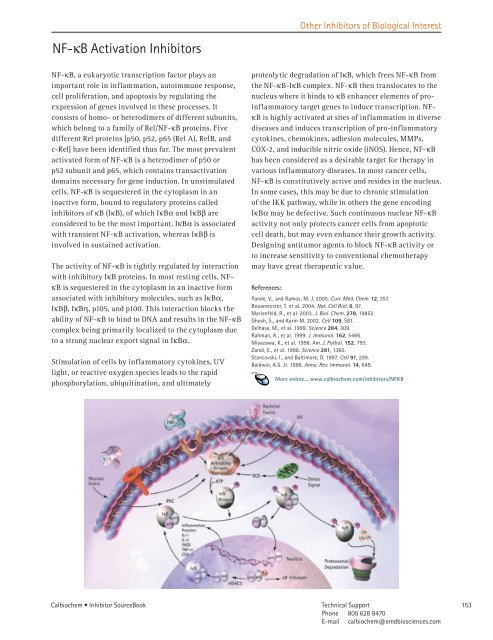Inhibitor SourceBook™ Second Edition
Inhibitor SourceBook™ Second Edition
Inhibitor SourceBook™ Second Edition
You also want an ePaper? Increase the reach of your titles
YUMPU automatically turns print PDFs into web optimized ePapers that Google loves.
NF-kB Activation <strong>Inhibitor</strong>s<br />
NF-kB, a eukaryotic transcription factor plays an<br />
important role in inflammation, autoimmune response,<br />
cell proliferation, and apoptosis by regulating the<br />
expression of genes involved in these processes. It<br />
consists of homo- or heterodimers of different subunits,<br />
which belong to a family of Rel/NF-kB proteins. Five<br />
different Rel proteins [p50, p52, p65 (Rel A), RelB, and<br />
c-Rel] have been identified thus far. The most prevalent<br />
activated form of NF-kB is a heterodimer of p50 or<br />
p52 subunit and p65, which contains transactivation<br />
domains necessary for gene induction. In unstimulated<br />
cells, NF-kB is sequestered in the cytoplasm in an<br />
inactive form, bound to regulatory proteins called<br />
inhibitors of kB (IkB), of which IkBa and IkBb are<br />
considered to be the most important. IkBa is associated<br />
with transient NF-kB activation, whereas IkBb is<br />
involved in sustained activation.<br />
The activity of NF-kB is tightly regulated by interaction<br />
with inhibitory IkB proteins. In most resting cells, NFkB<br />
is sequestered in the cytoplasm in an inactive form<br />
associated with inhibitory molecules, such as IkBa,<br />
IkBb, IkBh, p105, and p100. This interaction blocks the<br />
ability of NF-kB to bind to DNA and results in the NF-kB<br />
complex being primarily localized to the cytoplasm due<br />
to a strong nuclear export signal in IkBa.<br />
Stimulation of cells by inflammatory cytokines, UV<br />
light, or reactive oxygen species leads to the rapid<br />
phosphorylation, ubiquitination, and ultimately<br />
Calbiochem • <strong>Inhibitor</strong> SourceBook<br />
Other <strong>Inhibitor</strong>s of Biological Interest<br />
proteolytic degradation of IkB, which frees NF-kB from<br />
the NF-kB-IkB complex. NF-kB then translocates to the<br />
nucleus where it binds to kB enhancer elements of proinflammatory<br />
target genes to induce transcription. NFkB<br />
is highly activated at sites of inflammation in diverse<br />
diseases and induces transcription of pro-inflammatory<br />
cytokines, chemokines, adhesion molecules, MMPs,<br />
COX-2, and inducible nitric oxide (iNOS). Hence, NF-kB<br />
has been considered as a desirable target for therapy in<br />
various inflammatory diseases. In most cancer cells,<br />
NF-kB is constitutively active and resides in the nucleus.<br />
In some cases, this may be due to chronic stimulation<br />
of the IKK pathway, while in others the gene encoding<br />
IkBa may be defective. Such continuous nuclear NF-kB<br />
activity not only protects cancer cells from apoptotic<br />
cell death, but may even enhance their growth activity.<br />
Designing antitumor agents to block NF-kB activity or<br />
to increase sensitivity to conventional chemotherapy<br />
may have great therapeutic value.<br />
References:<br />
Pande, V., and Ramos, M. J. 2005. Curr. Med. Chem. 12, 357.<br />
Bouwnecster, T. et al. 2004. Nat. Cell Biol. 6, 97.<br />
Marienfeld, R., et al. 2003. J. Biol. Chem. 278, 9852.<br />
Ghosh, S., and Karin M. 2002. Cell 109, S8 .<br />
Delhase, M., et al. 999. Science 284, 309.<br />
Rahman, A., et al. 999. J. Immunol. 162, 5466.<br />
Miyazawa, K., et al. 998. Am. J. Pathol. 152, 793.<br />
Zandi, E., et al. 998. Science 281, 360.<br />
Stancovski, I., and Baltimore, D. 997. Cell 91, 299.<br />
Baldwin, A.S. Jr. 996. Annu. Rev. Immunol. 14, 649.<br />
More online... www.calbiochem.com/inhibitors/NFKB<br />
Technical Support<br />
Phone 800 628 8470<br />
E-mail calbiochem@emdbiosciences.com<br />
53



